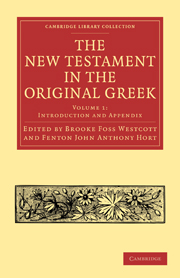IV - NATURE AND DETAILS OF THIS EDITION
Published online by Cambridge University Press: 29 August 2010
Summary
Aim and litnitations of this edition
375. The common purpose of all critical editions of ancient books, to present their text in comparative purity, is subject to various subordinate modifications. Our own aim, like that of Tischendorf and Tregelles, has been to obtain at once the closest possible approximation to the apostolic text itself. The facts of textual history already recounted, as testified by versions and patristic quotations, shew that it is no longer possible to speak of “the text of the fourth century”, since most of the important variations were in existence before the middle of the fourth century, and many can be traced back to the second century. Nor again, in dealing with so various and complex a body of documentary attestation, is there any real advantage in attempting, with Lachmann, to allow the distributions of a very small number of the most ancient existing documents to construct for themselves a provisional text by the application of uniform rules, and in deferring to a separate and later process the use of critical judgement upon readings. What is thus gained in facility of execution is lost in insecurity of result: and while we have been led to a much slower and more complex mode of procedure by the need of obtaining impersonal and, if the word may be forgiven, inductive criteria of texts, documents, and readings, we have at the same time found it alike undesirable and impossible to take any intermediate text, rather than that of the autographs themselves, as the pattern to be reproduced with the utmost exactness which the evidence permits.
- Type
- Chapter
- Information
- The New Testament in the Original Greek , pp. 288 - 324Publisher: Cambridge University PressPrint publication year: 2010First published in: 1881



